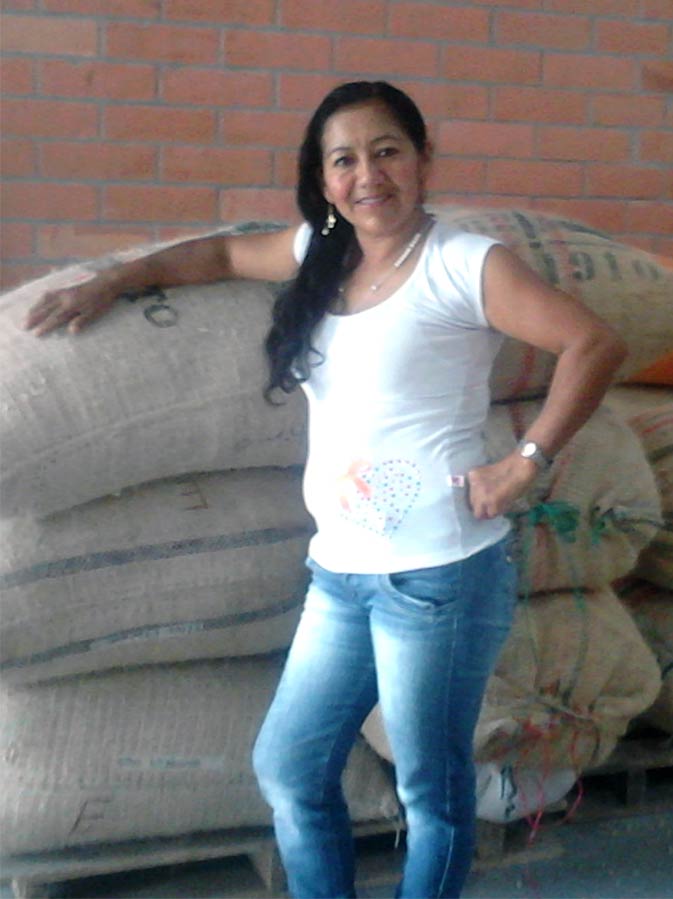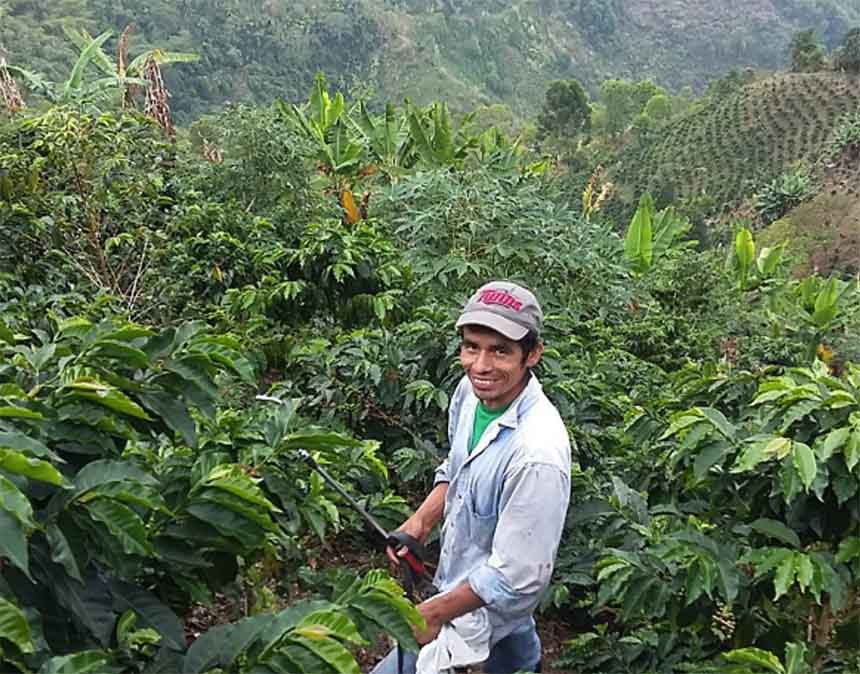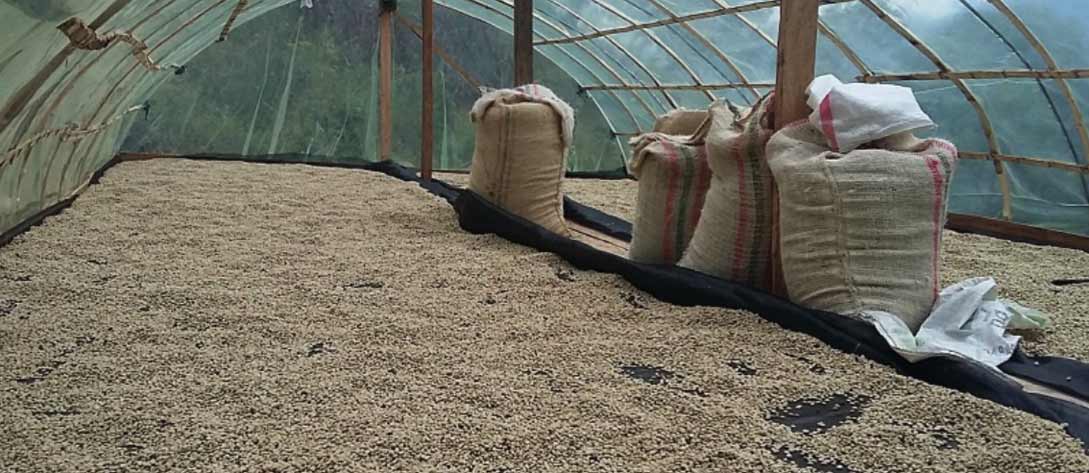-
Producer
-
Maria Edilma Medina
-
Country
- Colombia
-
Region
-
Gigante, Huila
-
Altitude
-
1700m above sea level
-
Varieties
-
Process
-
Importer
-
Caravela
-
Body
-
Medium
-
Acidity
-
Medium
-
Tasting notes
-
Rosehip, red apple, hazelnut
-
Roast style
Colombia
Maria Edilma Medina
2017We’re back in Colombia for this delivery (and returning to a farm featured last year) with this lot from Finca La Esperanza (Hope).
Maria came to Gigante around ten years ago because of violence and conflicts elsewhere. Using savings and a bank loan, she bought La Esperanza farm in partnership with Elias and Isaias Lizcano. Elias is her father-in-law and he helps her to manage the farm and is in charge of all the quality inspections.
 Maria, alongside bags of coffee ready for transport. Photo: Caravela Coffee
Maria, alongside bags of coffee ready for transport. Photo: Caravela Coffee
At 1,700 metres above sea-level, La Esperanza is a relatively high altitude crop and has a total area of around nine hectares.
Last year she produced around 1,100kg of AA, AA+, AAA, and now ML, a grade which recognises microlots of very high quality coffee.
La Esperanza sits 1,700 metres above sea-level and is around nine hectares. After this year’s pruning to prevent leaf rust and ensure healthy future crops, she has 1,600 caturra trees in production and 2,000 castillo trees.
For Maria, the move from commodity coffee to specialty coffee was a great way to improve her life: the money she has received has helped to pay some of her debts and also to better provide for her family. Before focusing on specialty coffee she says it was difficult to take care of her farm because of a lack of money, but she’s now able to fertilise and make all roya (leaf rust) controls on time, further improving the quality of her crop.
 Photo: Caravela Coffee
Photo: Caravela Coffee
She’s proud to be producing specialty coffee and says she has learned a great deal. After studying the PECA education program run by our sourcing partners Caravela, Maria has better practices for managing the farm, with the higher quality crops being recognised by the market with much better prices.
Maria wants to improve in every lot she produces and hopes to continue having coffee that reaches ML (microlot) grades.
 Photo: Caravela Coffee
Photo: Caravela Coffee
Castillo
Castillo is a varietal that we usually see in a mixed lot Caturra such as this one.
Castillo is a more disease-resistant plant with much higher yields, created by Federación Nacional de Cafeteros de Colombia’s research arm CENICAFE as a hybrid of Caturra and Timor varietals, but which remains similar enough to Caturra to have a the same flavour profile.
Initial suspicions of Colombian farmers following its release in 2005, together with some poor-quality first crops earned Castillo a bad reputation.
Thanks to some very high-quality crops, this reputation is now being challenged, and we’re hopeful that the industry’s desire for flavour-rich, high-quality crops can be met with by a varietal that also gives farmers security against the coffee rust fungus.
The US Speciality Coffee Association has led blind sensory and cupping tests which showed Castillo and Caturra producing similar scores, though with slightly different flavours.
They found that the geographic location and farming techniques had a greater impact on score than the varietal:
For farmers choosing between Castillo and Caturra, what they choose to plant may have less impact on cup quality than where and how they grow it. The data from both the cupping panels at Intelligentsia and the sensory analysis at KSU show that cup scores are more strongly correlated with environment and management than with variety.
In other words, growers may do more to increase cup quality through more active soil and shade management, careful harvesting, and improved post-harvest practices than through the intentional selection of one of these varieties over another.
The farms in the trial that produced exceptional Castillo samples also produced exceptional Caturra samples, meaning that high quality was more a function of where farmers are planting coffee and how they are managing it than which variety they are planting.
Some environments are simply better suited than others to produce high cup quality. The problem is that few growers know whether they are in one of those agroecological niches or not. We commonly use elevation as a proxy for quality potential, but are many other environmental variables that affect the suitability of a particular growing environment for high-quality coffee.
Learn everything about this coffee:
Ethical, traceable sourcing
This page has all the sourcing information (variety, process, region, story, importer, and more) that our importers share with us, and give us permission to use.
The transparency helps us talk confidently about the quality and background of our product, and it helps you know exactly what you’re buying.
Learn more:
Coffee page transparency legend
Our coffee philosophy
Our business approach
Fresh harvest coffee
We only source and roast coffee from each country’s latest harvest season (so the green coffee is never older than 1 year from the time of picking, processing and packing). This ensures the sensory qualities are always at their peak and unaffected by excessive ageing.
Roasted for espresso and filter (best enjoyed black)
Roast style: omni. Omni roasts are designed to brew and taste great both as espresso and filter. Our omni single origins generally sit on Agtron values in the ~70-60 value range. So, technically, they are somewhere in the lighter side of the medium spectrum.
Designed for espresso and filter brewing. Best enjoyed black.
Learn more:
Our Loring Kestrel S35 roaster
Our roasting style and approach
Best brewed within days 15-49 post-roast
The ‘fresh is best’ saying doesn’t apply to coffee (contrary to popular belief). Waiting before opening and brewing your bag of whole coffee beans helps develop peak flavour and acidity.
But heads up: if you buy pre-ground coffee, brew it as soon as possible.
Learn more:
Our recommended brewing window
Try our custom brewing recipes
Our recipes and ratios are tailored to our coffee sourcing and roasting styles, bringing the best flavour and feel out of each coffee.
For pour over, immersion, and other filter brewing styles, check our brew guides.
For our espresso single origins, we recommend a coffee:yield ratio of 1:3:
- Dose: 20g ground coffee
- Yield: 60g espresso
- Total brew time: ~24-28 seconds
This is just a starting point! We encourage you to experiment, taste, and adjust to find the recipe that you enjoy the most.
Learn more:
Our espresso brew guide (single origin)
Brewing ratio calculator
Packaging and sustainability
- Bags: ABA-certified home compostable (AS 5810-2010)
- Labels: recyclable
- Valves (only on +250g bags): general waste
- Box and tape (online orders): recyclable
Learn more:
Our packaging
Varieties
Castillo variety
Castillo is named after the researcher Jamie Castillo, who helped develop the varietal in 2005 by Cenicafe, Colombia’s coffee research centre
Caturra variety
Caturra is a natural mutation of Bourbon that was originally discovered in Brazil in 1937, considered to be the first naturally occurring mutation ever discovered.
The location
Coffee from Colombia
Colombia is one of the largest coffee producers in the world and benefits greatly from having one of the most unique and complex set of micro-climates of all coffee producing nations.
The Huila region of Colombia
This region boasts the perfect combination of high quality soil and geography and is quickly becoming one of the largest coffee producing regions in Colombia. One of the best regarded regions for high quality, fruit driven coffee.
Farm processes
Washed process
Machines are used to remove the flesh from the coffee cherry before being fermented in water, washed again, and finally sun dried. This process tends to result in more distinct, cleaner flavours.

Subscribe to a world of coffee
Discover a new single origin coffee from Sample every 1-5 weeks with no delivery fees.
No up-front purchase, and you can pause, cancel, or change plans at any time.
Available to order online this week:

El Salvador Manuel Castañeda
Flavours of toffee apple, cranberry, dulce de leche
Body Acidity
Honey Pacamara
March 2025 harvest
Roasted omni for filter and espresso
El Salvador Manuel Castañeda online
Ethiopia Bekele Gemeda
Flavours of mandarin, white peach, mango
Body Acidity
Washed Ethiopian Heirloom
November 2024 harvest
Roasted omni for filter and espresso
Ethiopia Bekele Gemeda online
Colombia Jose Elcias Martinez Guzman Pink Bourbon
Flavours of mandarin, burnt orange, pineapple
Body Acidity
Washed Pink Bourbon
December 2024 harvest
Roasted omni for filter and espresso
Colombia Jose Elcias Martinez Guzman Pink Bourbon online